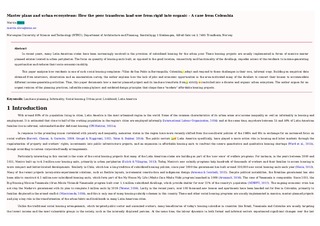| dc.contributor.author | Sliwa, Marcin | |
| dc.date.accessioned | 2018-05-02T14:05:25Z | |
| dc.date.available | 2018-05-02T14:05:25Z | |
| dc.date.created | 2017-05-24T13:23:33Z | |
| dc.date.issued | 2017 | |
| dc.identifier.citation | Habitat International. 2017, 66 1-12. | nb_NO |
| dc.identifier.issn | 0197-3975 | |
| dc.identifier.uri | http://hdl.handle.net/11250/2496841 | |
| dc.description.abstract | In recent years, many Latin-American states have been increasingly involved in the provision of subsidized housing for the urban poor. These housing projects are usually implemented in forms of massive master planned estates located in urban peripheries. The focus on quantity of housing units built, as opposed to the good location, connectivity and functionality of the dwellings, impedes access of the residents to income-generating opportunities and reduces their socio-economic mobility. This paper analyzes how residents in one of such social housing complexes –Villas de San Pablo in Barranquilla, Colombia– adopt and respond to these challenges in their own, informal ways. Building on empirical data obtained from interviews, observation and an enumeration survey, the author explains how the lack of jobs and economic opportunities in the area motivated many of the dwellers to convert their houses to accommodate different income-generating activities. Thus, this paper documents how a master planned project and its land-use transform from a strictly controlled into a diverse and organic urban ecosystem. The author argues for an urgent revision of the planning practices, inflexible zoning bylaws and outdated design principles that shape these “modern” affordable housing projects. | nb_NO |
| dc.language.iso | eng | nb_NO |
| dc.publisher | Elsevier | nb_NO |
| dc.relation.uri | http://www.sciencedirect.com/science/article/pii/S0197397517301248 | |
| dc.rights | Attribution-NonCommercial-NoDerivatives 4.0 Internasjonal | * |
| dc.rights.uri | http://creativecommons.org/licenses/by-nc-nd/4.0/deed.no | * |
| dc.subject | Boligsosiale tiltak | nb_NO |
| dc.subject | Social housing | nb_NO |
| dc.subject | Ariel bruk | nb_NO |
| dc.subject | Land Use and regulations | nb_NO |
| dc.subject | Latin-Amerika | nb_NO |
| dc.subject | Latin America | nb_NO |
| dc.subject | Byromsutvikling | nb_NO |
| dc.subject | Urban development | nb_NO |
| dc.title | Master plans and urban ecosystems: How the poor transform land-use from rigid into organic - A case from Colombia | nb_NO |
| dc.type | Journal article | nb_NO |
| dc.type | Peer reviewed | nb_NO |
| dc.description.version | acceptedVersion | nb_NO |
| dc.subject.nsi | VDP::Urbanisme: 237 | nb_NO |
| dc.subject.nsi | VDP::Urbanism: 237 | nb_NO |
| dc.source.pagenumber | 1-12 | nb_NO |
| dc.source.volume | 66 | nb_NO |
| dc.source.journal | Habitat International | nb_NO |
| dc.identifier.doi | 10.1016/j.habitatint.2017.05.003 | |
| dc.identifier.cristin | 1471850 | |
| dc.description.localcode | © 2017. This is the authors’ accepted and refereed manuscript to the article. Locked until 24.5.2019 due to copyright restrictions. This manuscript version is made available under the CC-BY-NC-ND 4.0 license http://creativecommons.org/licenses/by-nc-nd/4.0/ | nb_NO |
| cristin.unitcode | 194,61,50,0 | |
| cristin.unitname | Institutt for arkitektur og planlegging | |
| cristin.ispublished | true | |
| cristin.fulltext | postprint | |
| cristin.qualitycode | 1 | |

